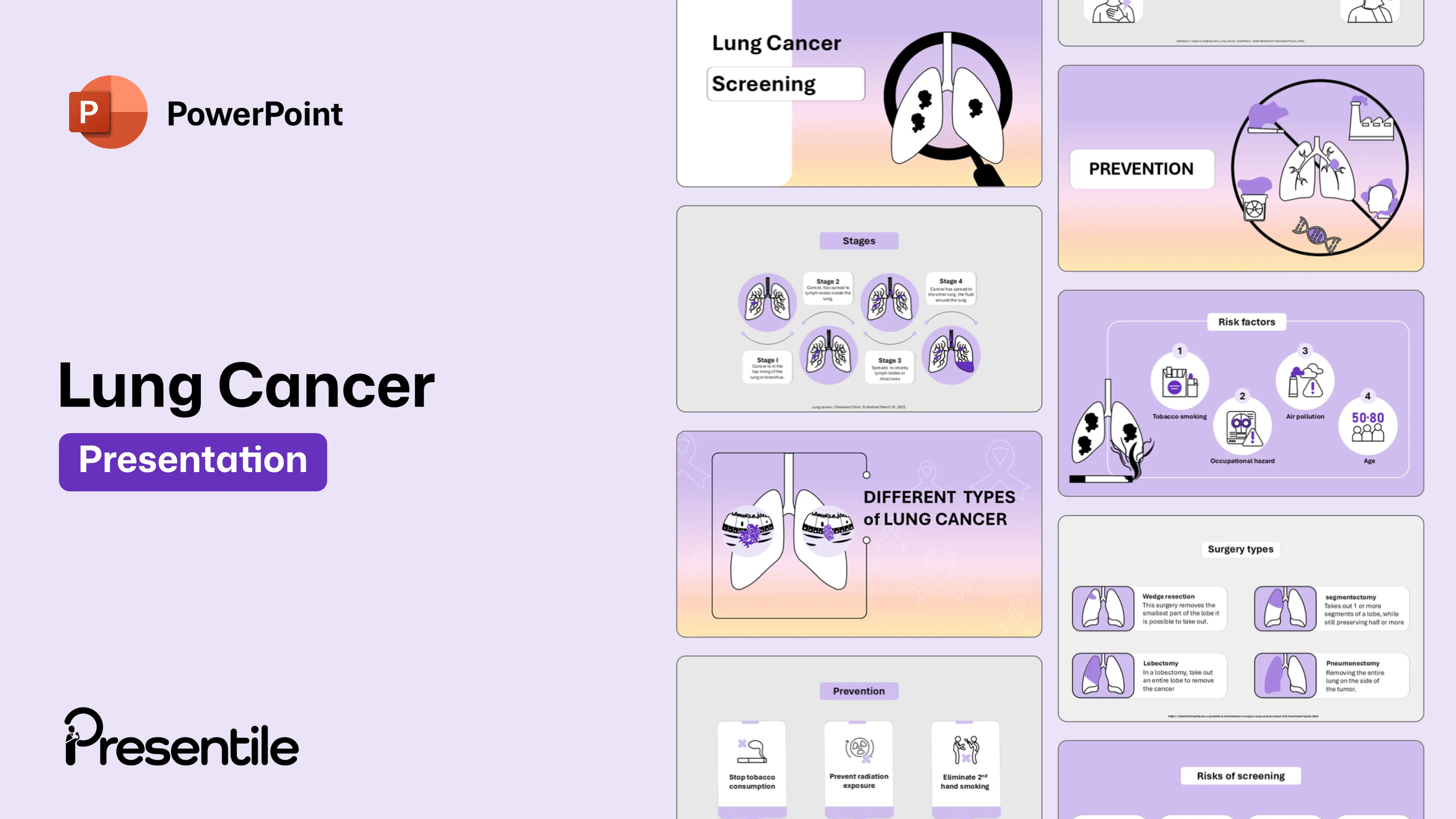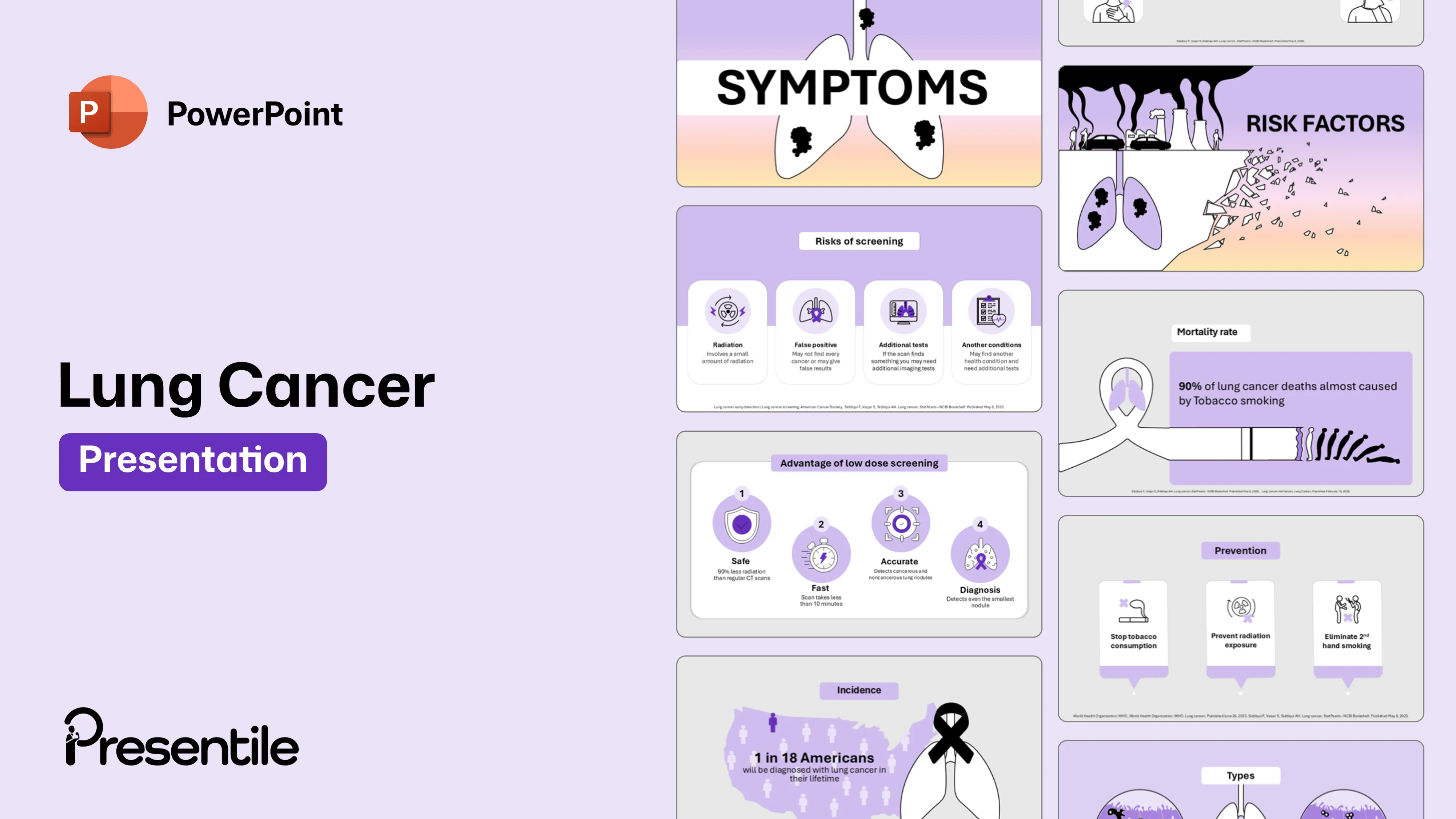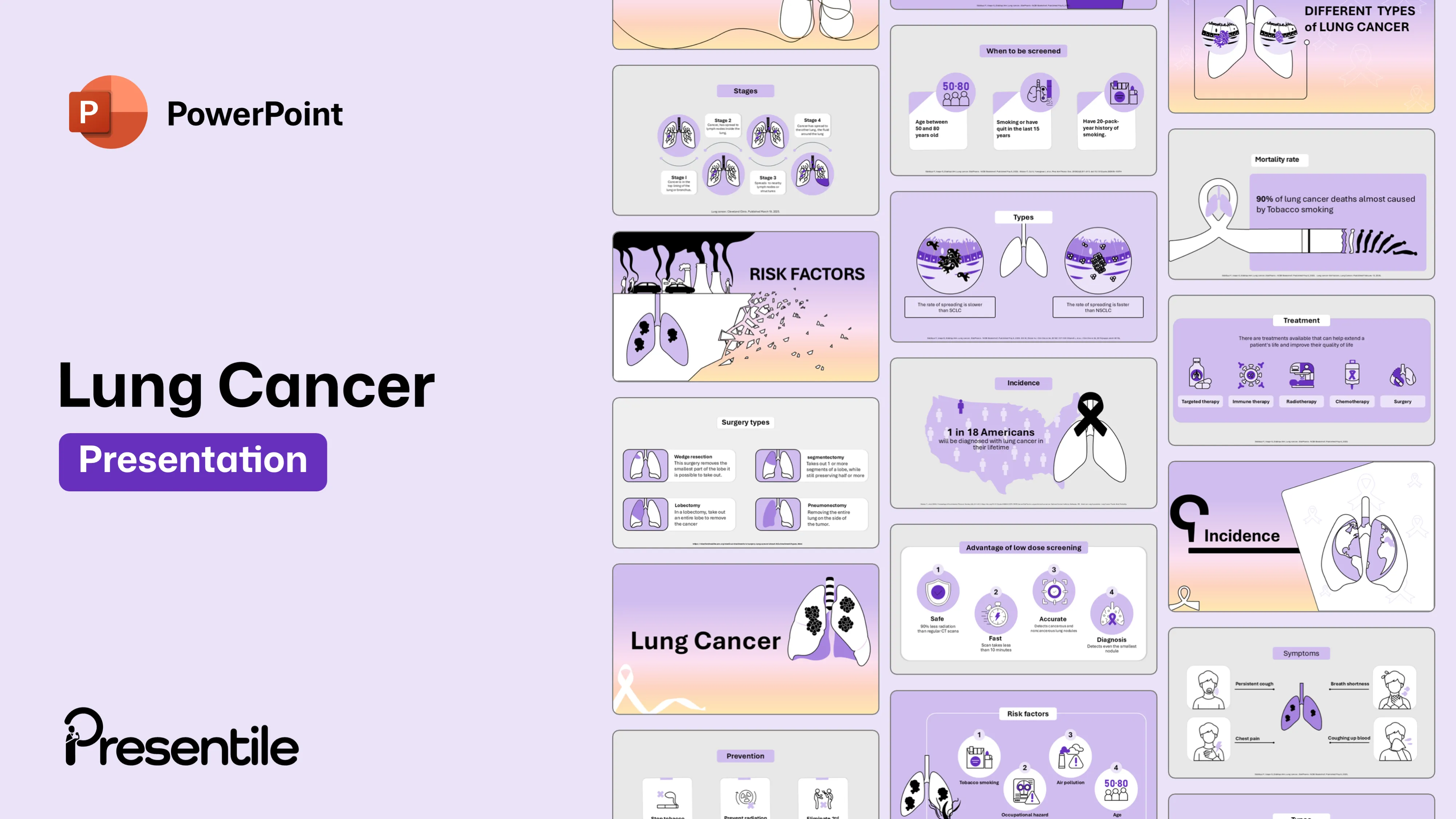
Content of
Lung Cancer Presentation
Slide 1: Lung Cancer
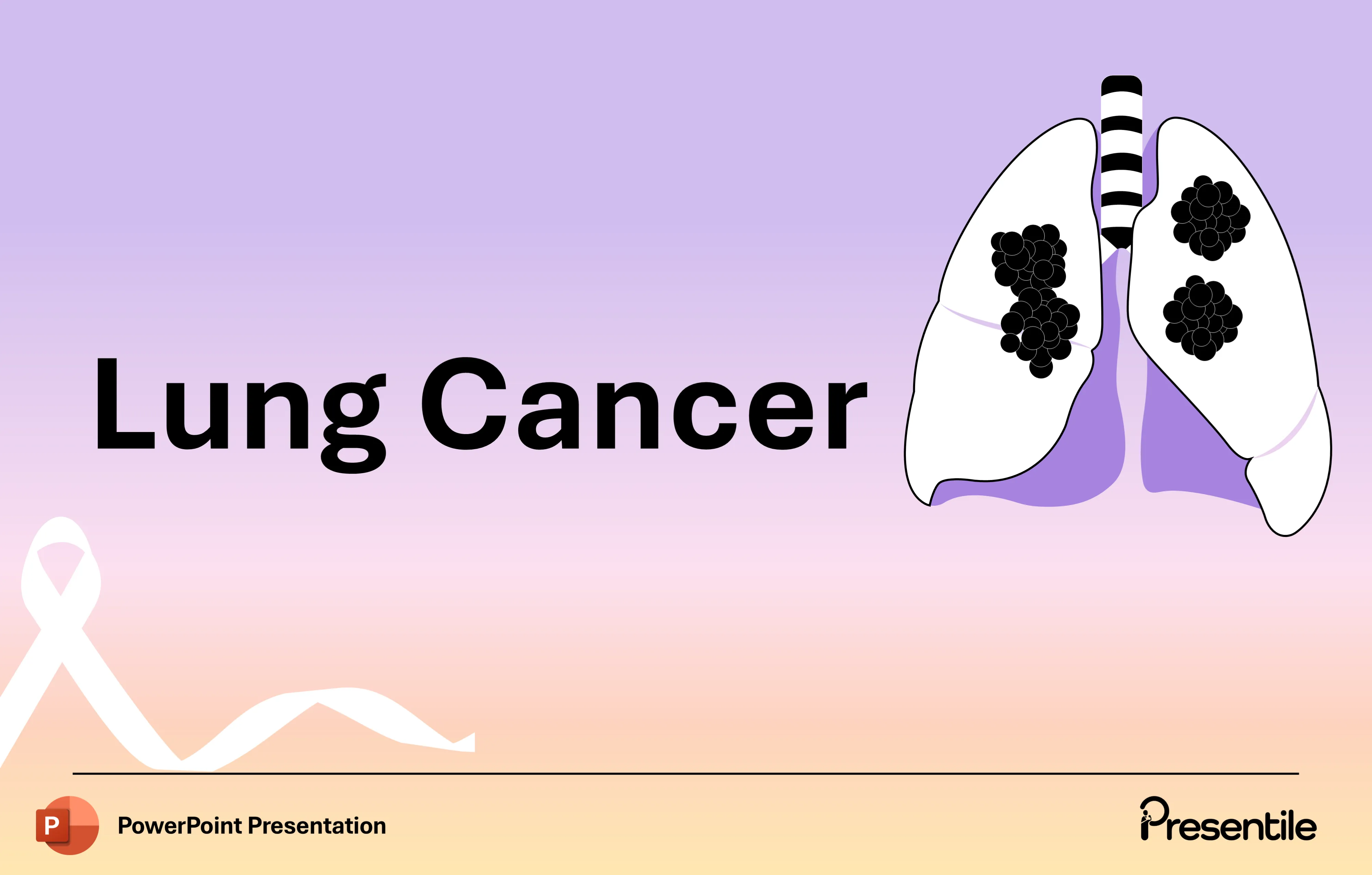
- This title slide provides a striking and impactful introduction to a presentation on Lung Cancer.
- The design uses a powerful visual—a pair of lungs with noticeable black masses, clearly illustrating the disease's pathology.
- A white awareness ribbon is featured in the bottom left, symbolizing support and a call to action.
- The clean layout and direct heading, "Lung Cancer," ensure the topic is immediately clear.
- This slide sets a serious and professional tone, perfect for attracting your audience's attention.
Slide 2: The Definition of Lung Cancer
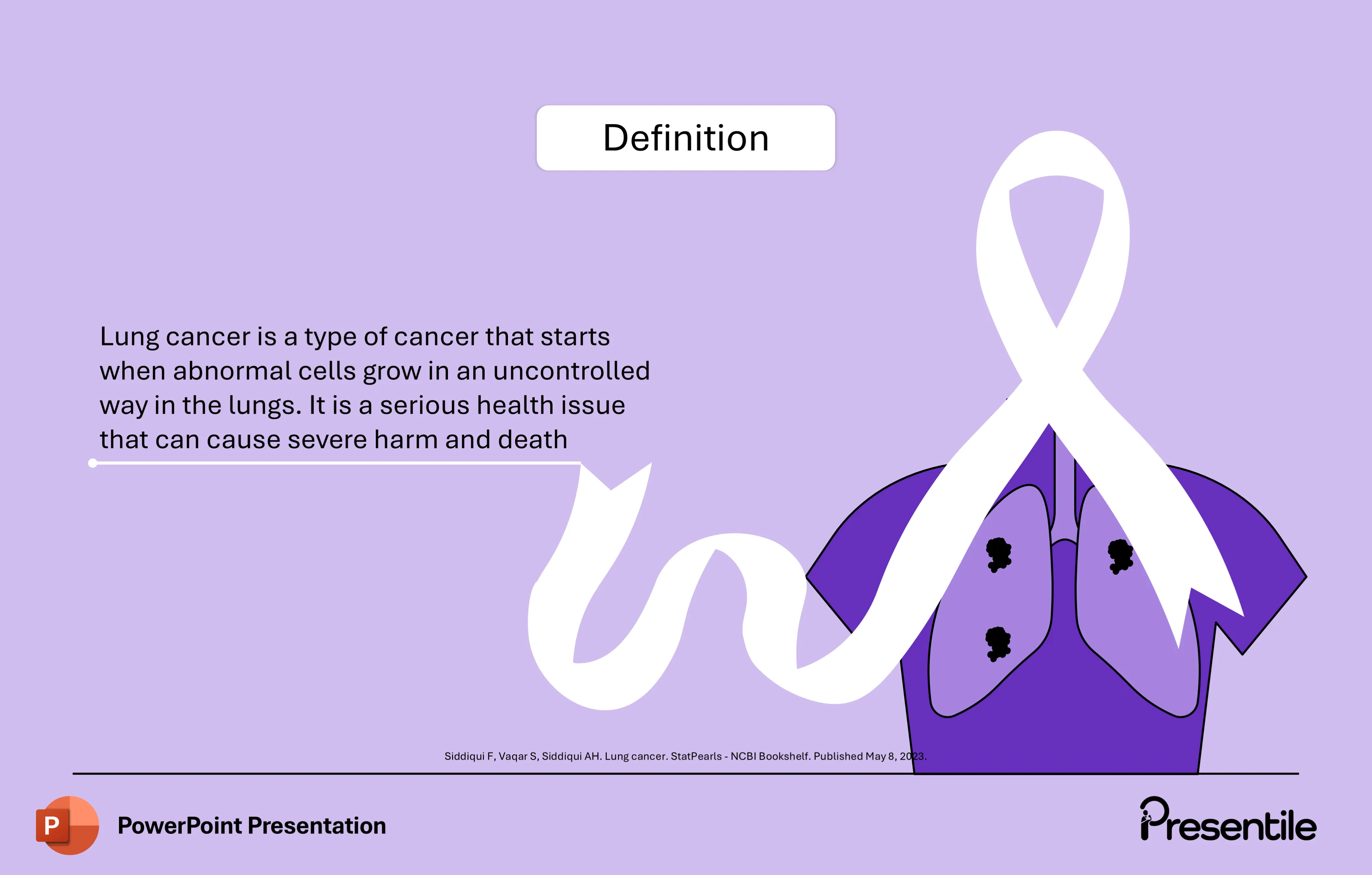
- This slide provides a clear and concise definition of lung cancer.
- It explains that it's a type of cancer that begins when abnormal cells grow in an uncontrolled way in the lungs, highlighting it as a serious health issue that can cause severe harm and death.
- The visual of a white ribbon flowing through a pair of lungs with cancerous growths provides a powerful and empathetic message, connecting the clinical definition to the broader human experience of the disease.
- The inclusion of a source citation at the bottom adds to the credibility and professionalism of the information.
Slide 3: Incidence of Lung Cancer
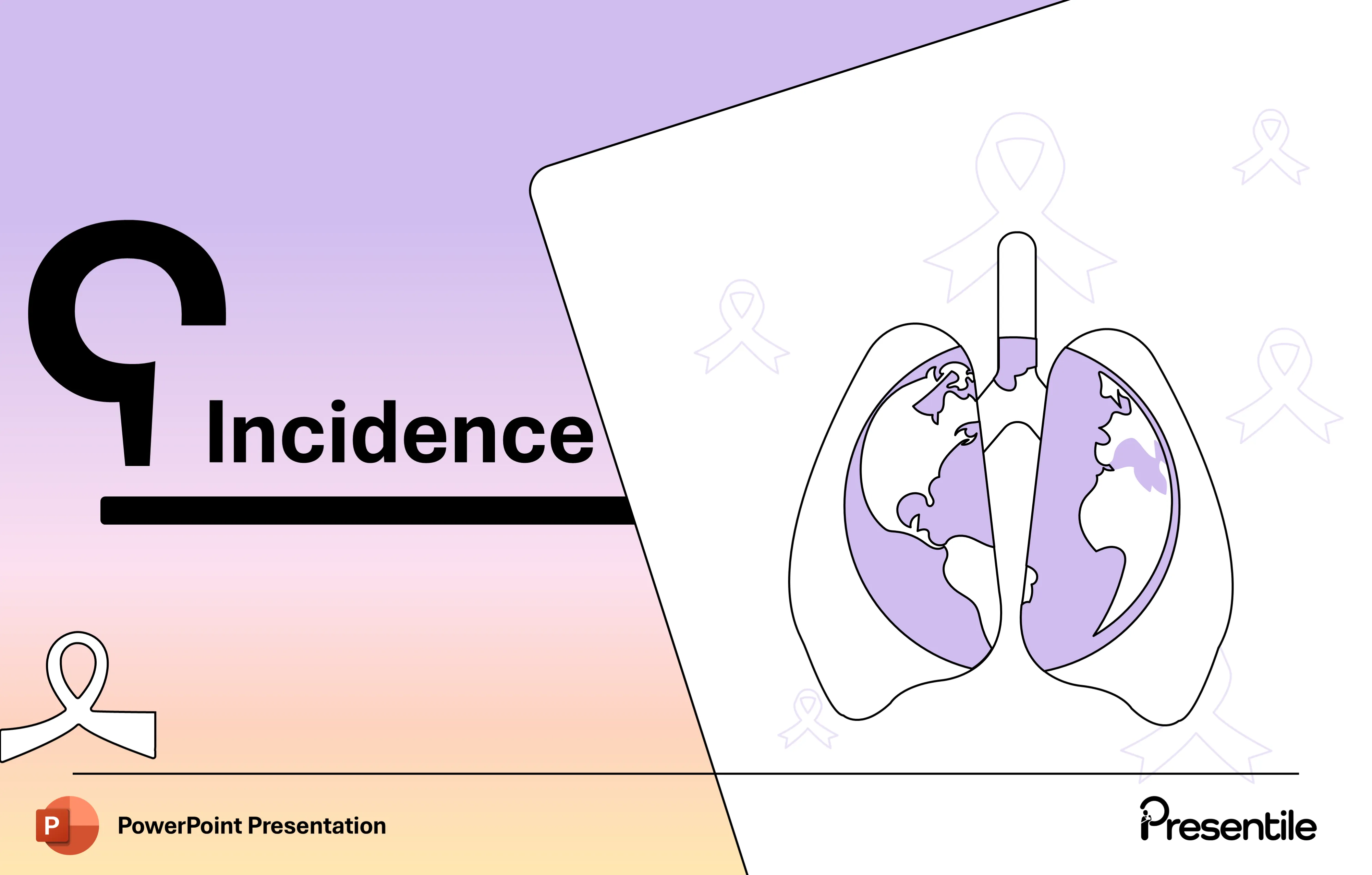
- This section slide introduces the topic of lung cancer incidence.
- The design uses an impactful visual of a pair of lungs containing a world map, symbolizing the global scale of the disease.
- The title "Incidence" is prominently displayed, signaling a shift in focus from the disease's definition to its statistical occurrence.
- This slide provides a clear and engaging way to introduce data and statistics related to lung cancer, attracting your audience's attention with a strong visual element.
Slide 4: The Incidence of Lung Cancer in the U.S.
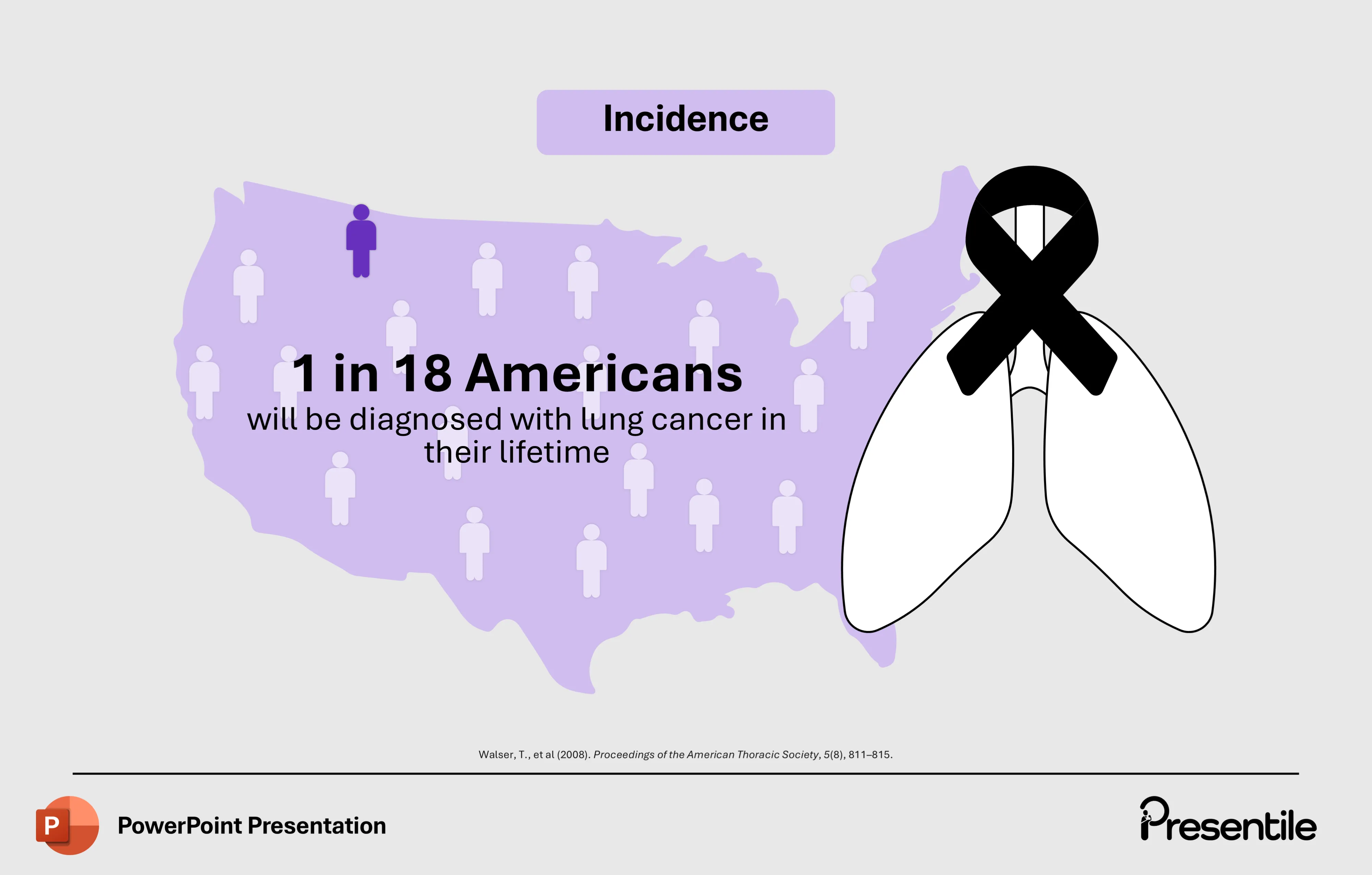
- This slide provides specific data on the incidence of lung cancer in the U.S., effectively communicating the widespread nature of the disease.
- The map of the United States serves as the backdrop, while the bold text "1 in 18 Americans will be diagnosed with lung cancer in their lifetime." This statistic provides a powerful and easily digestible piece of information.
- The visual of a black awareness ribbon and a single highlighted figure on the map further reinforces the impact of this disease on the population.
- This slide effectively translates complex epidemiological data into a compelling and clear visual statement.
Slide 5: Mortality Rate of Lung Cancer
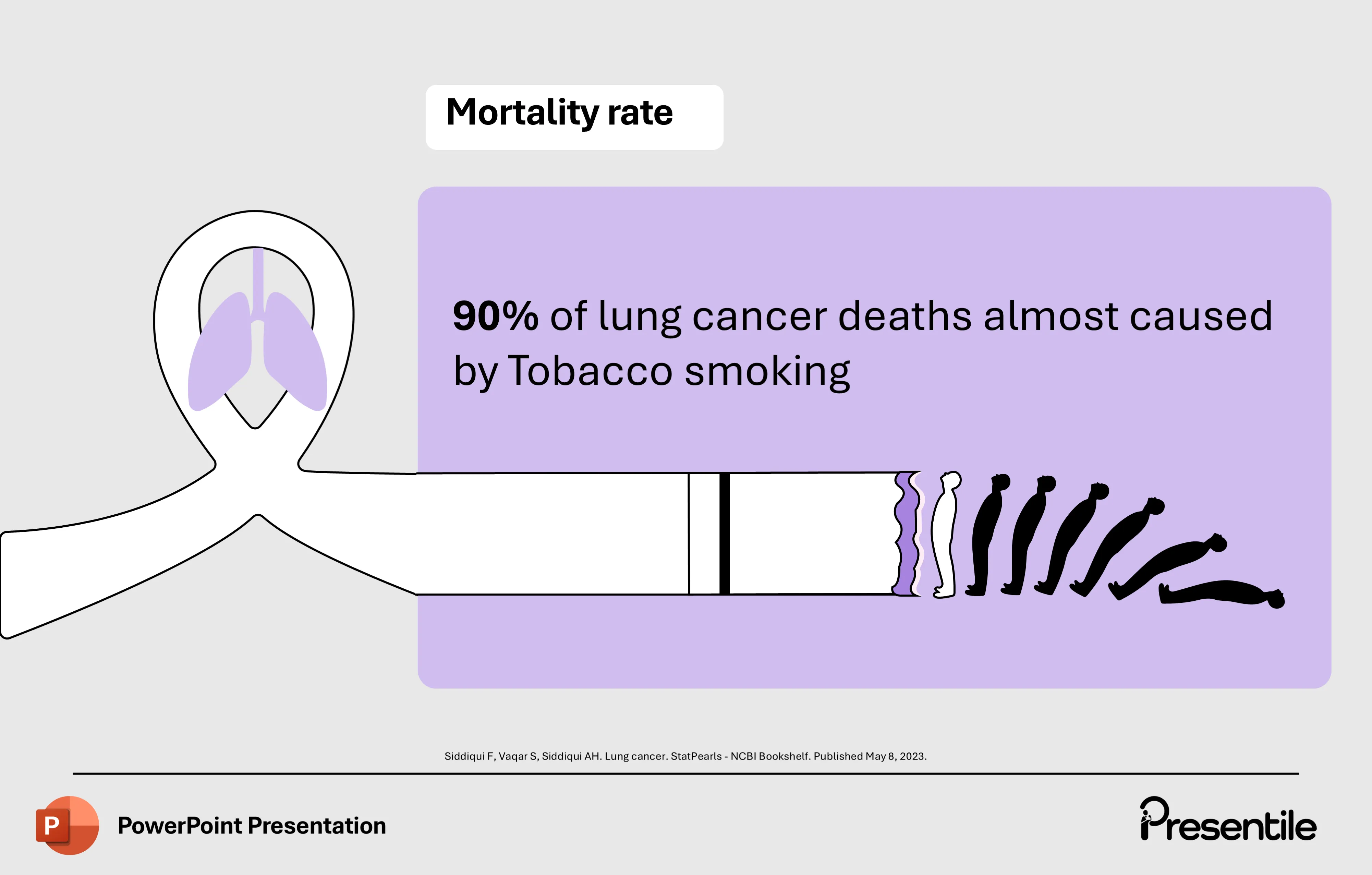
- This slide highlights a critical statistic about the mortality rate of lung cancer and its primary cause.
- The text states that "90% of lung cancer deaths are almost caused by Tobacco smoking." The visual powerfully reinforces this message by showing a cigarette, with figures falling out of it, and a pair of lungs linked by a ribbon.
- This striking graphic and the bold statistic effectively convey the severe impact of smoking on lung cancer mortality.
Slide 6: Lung Cancer: Symptoms
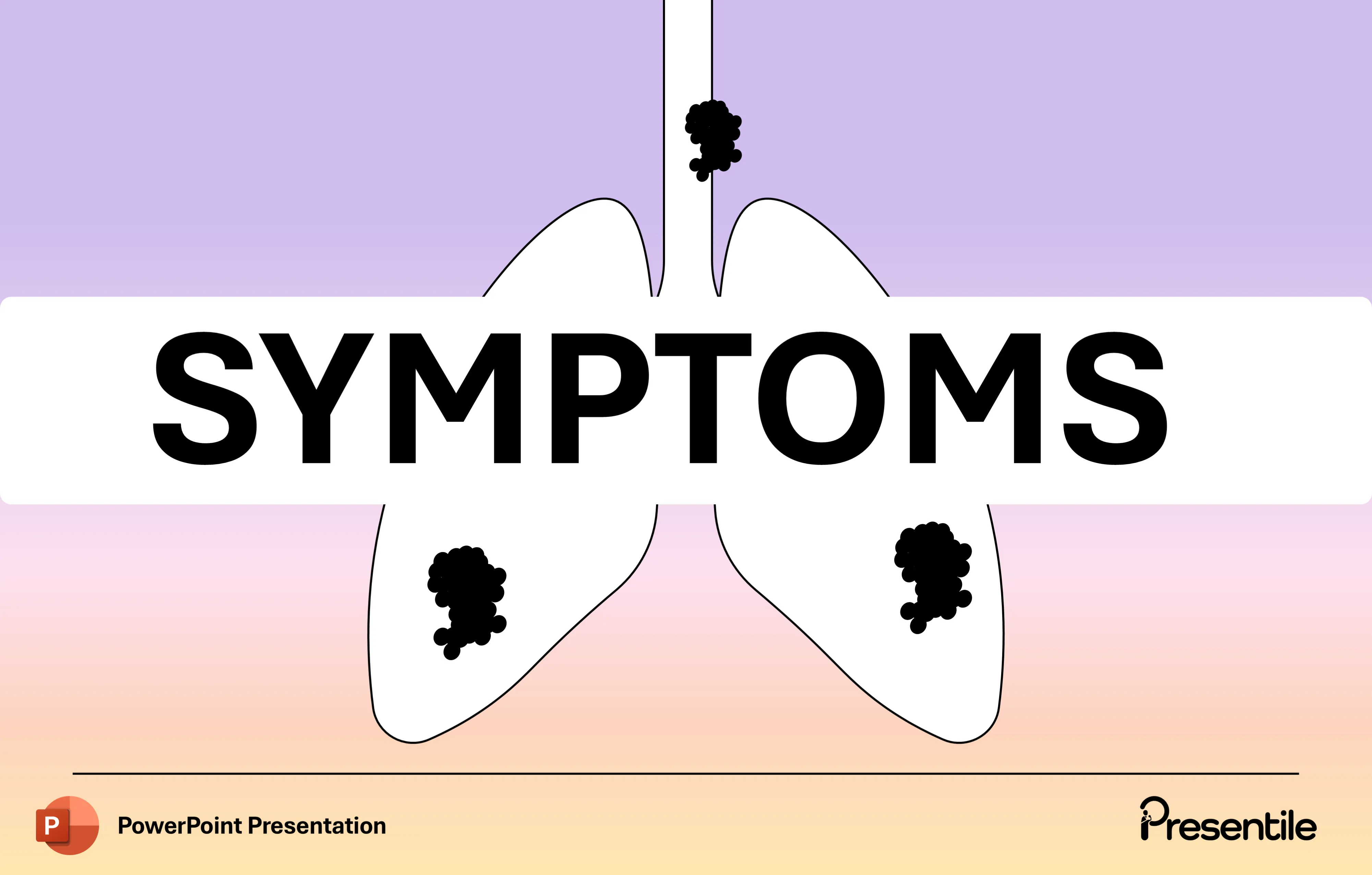
- This slide acts as a section break, introducing the topic of symptoms related to lung cancer.
- The background visual of a pair of lungs with cancerous masses, combined with the bold "SYMPTOMS" text, immediately draws attention to the subject matter.
- This design effectively signals a shift in the presentation's focus, preparing the audience for a detailed breakdown of the clinical manifestations of the disease.
Slide 7: Key Symptoms of Lung Cancer
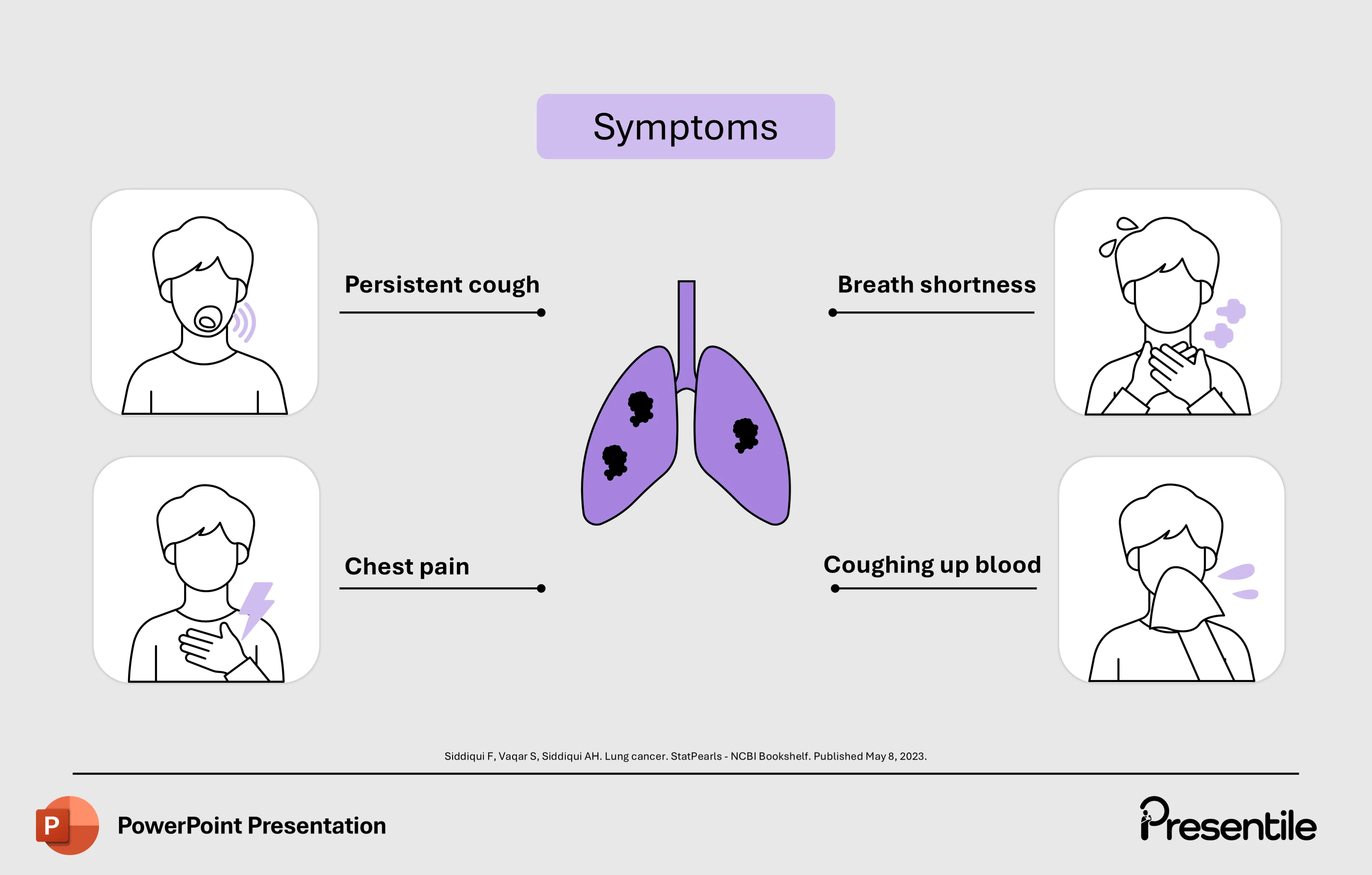
- This slide provides a clear visual breakdown of the most common symptoms of lung cancer.
- Four distinct icons represent the key clinical signs: a person with a persistent cough, an individual experiencing breath shortness, a person with chest pain, and someone coughing up blood.
- The central image of a pair of lungs with cancerous growths ties these symptoms directly to the underlying disease.
- This organized layout makes it easy for the audience to quickly grasp the primary indicators of the condition.
Slide 8: Lung Cancer: Risk Factors
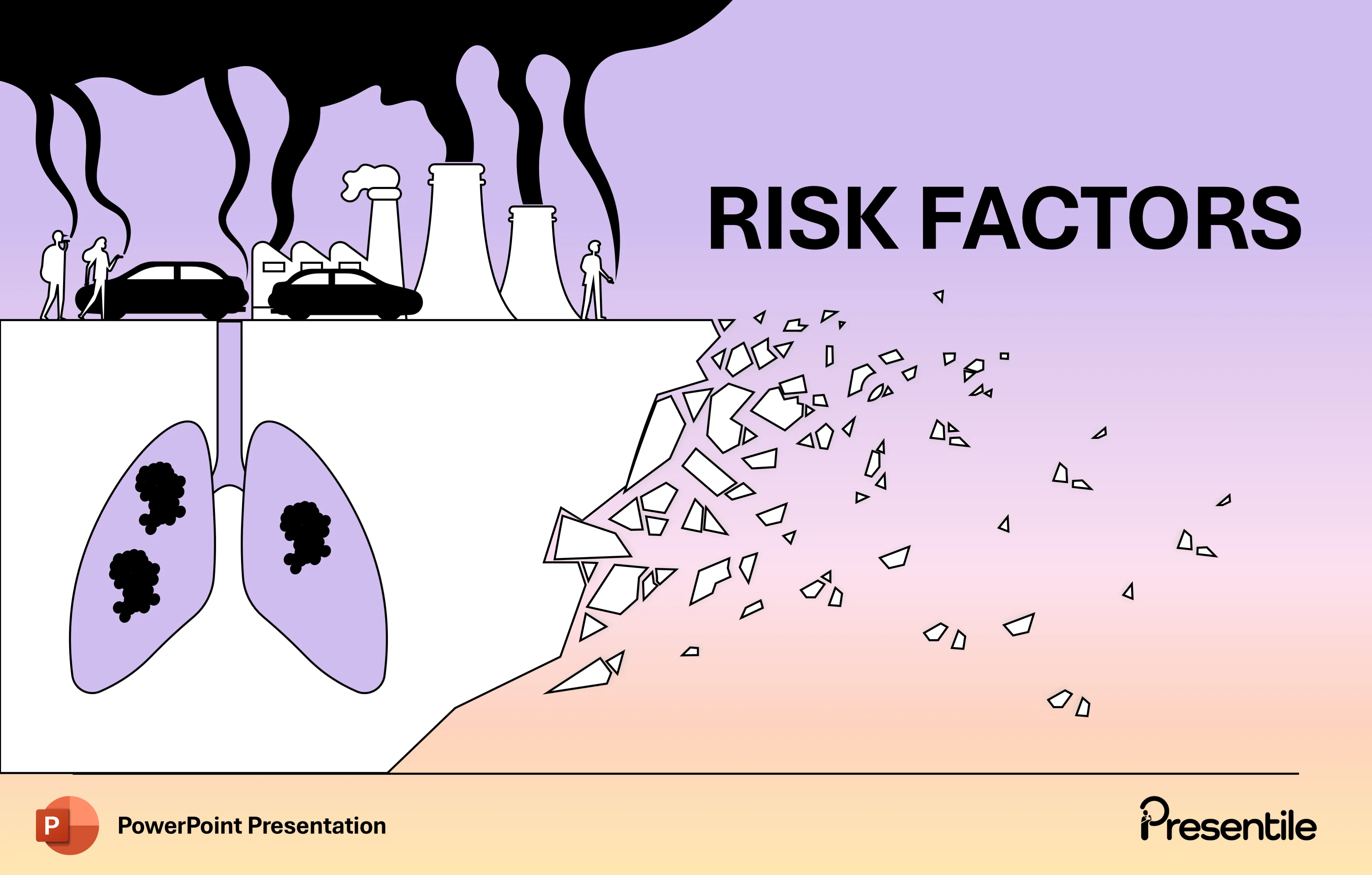
- This slide acts as a section break, introducing the topic of risk factors for lung cancer.
- The visual features an industrial landscape on the left, with smoke-spewing factories and vehicles symbolizing environmental pollutants.
- The text "RISK FACTORS" is prominently displayed, drawing the audience's attention.
- The crumbling ground and a pair of lungs with cancerous growths effectively connect these external factors to the disease.
- This powerful and direct visual sets the stage for a discussion on the various elements that can increase an individual's risk of developing lung cancer.
Slide 9: Four Risk Factors for Lung Cancer
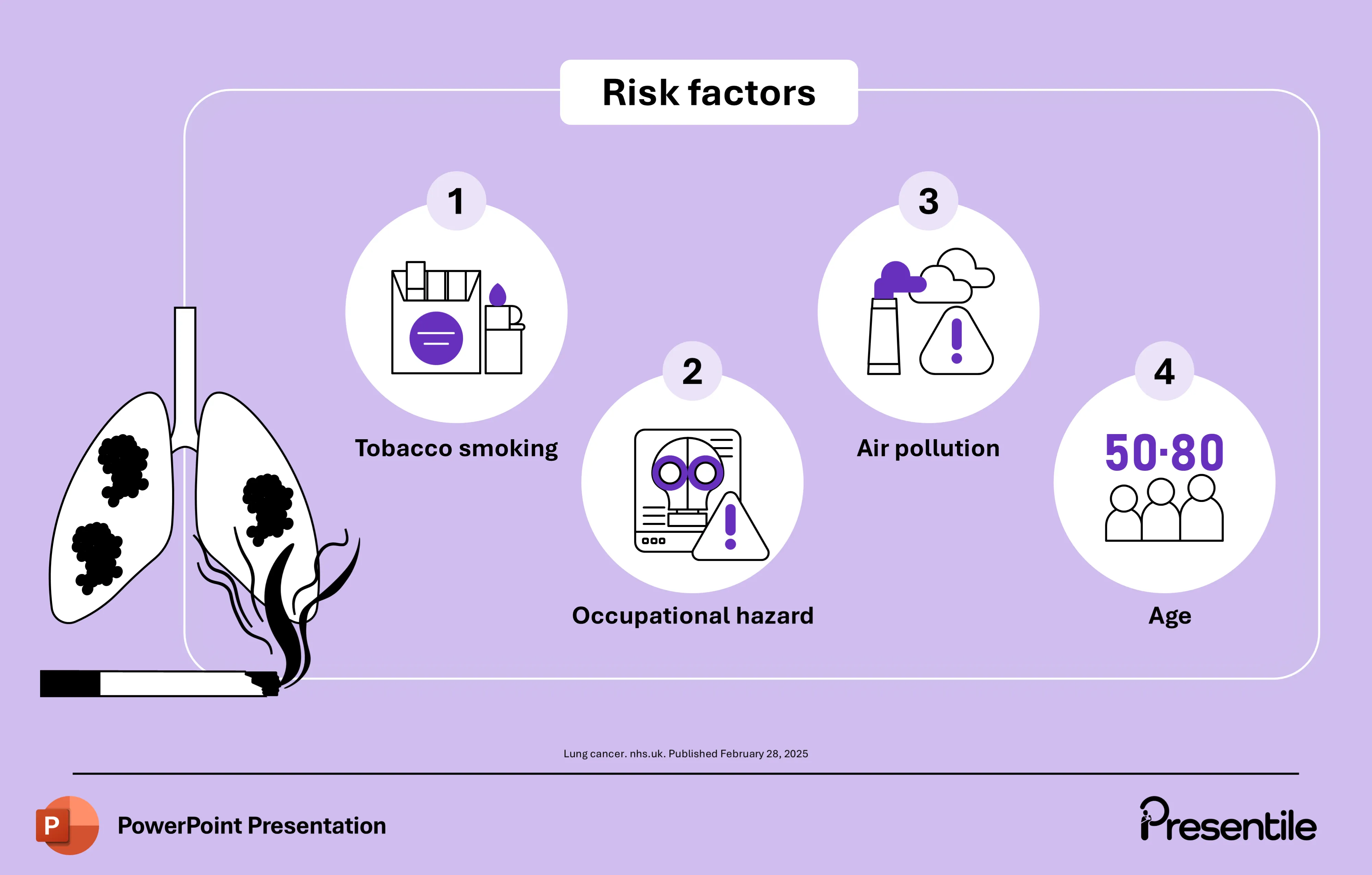
- This slide provides a clear overview of the four main risk factors for lung cancer.
- The design is clean and organized, with a central pair of lungs on a cigarette to reinforce the primary cause.
- The four numbered icons represent key risk factors: tobacco smoking, occupational hazards, air pollution, and age.
- This visual arrangement makes the information easy to digest and remember, effectively communicating the primary causes of the disease.
Slide 10: Types of Lung Cancer
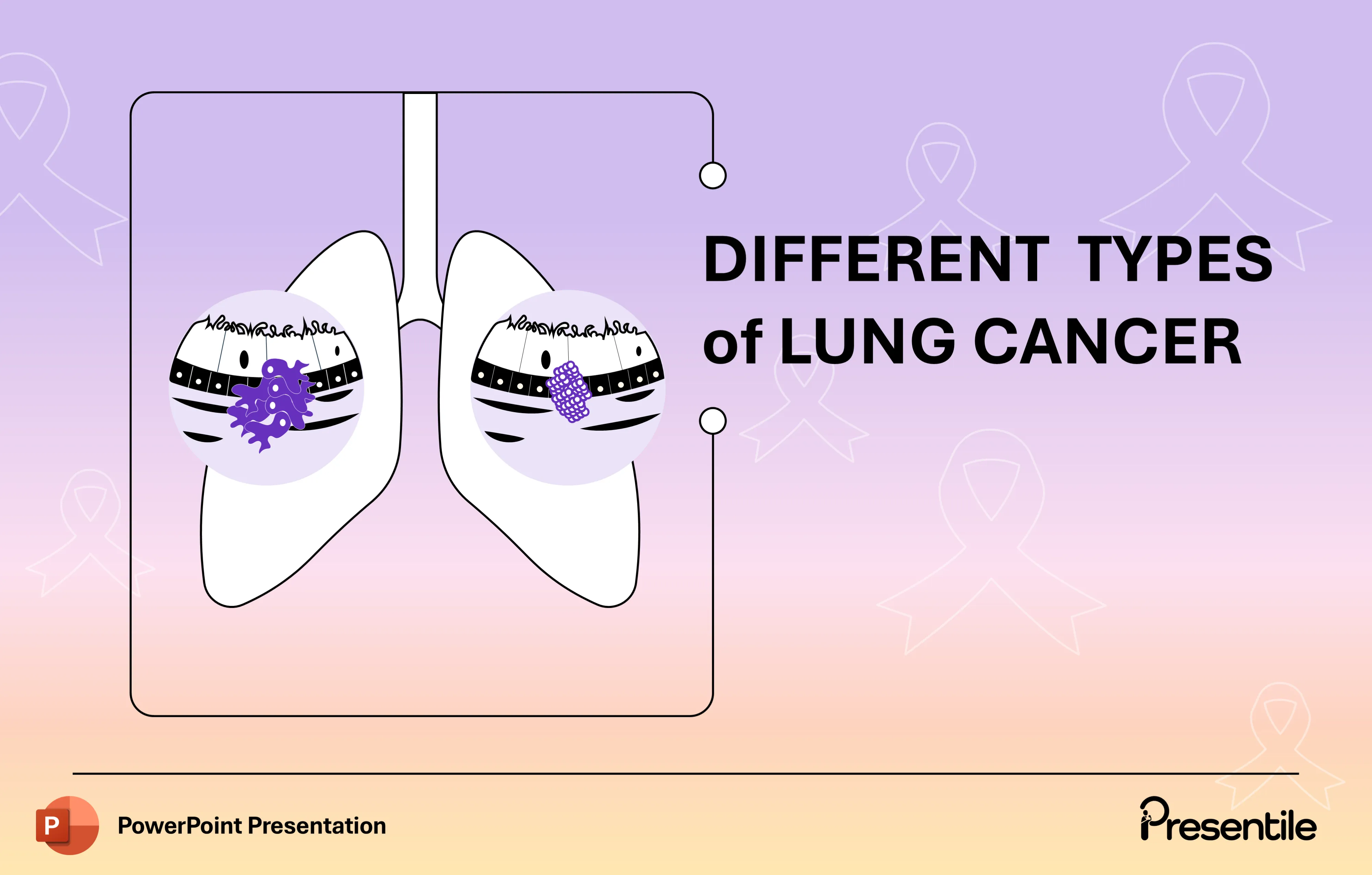
- This slide acts as a section break, introducing the topic of the different types of lung cancer.
- The design uses a pair of lungs in a stylized frame, with two magnified sections that represent different cellular structures, suggesting a classification of the disease.
- The text "DIFFERENT TYPES of LUNG CANCER" is prominently displayed, signaling a shift in focus from symptoms and risk factors to the specific classifications of the disease.
- This slide effectively prepares the audience for a more detailed discussion of lung cancer pathology.
Slide 11: Two Main Types of Lung Cancer
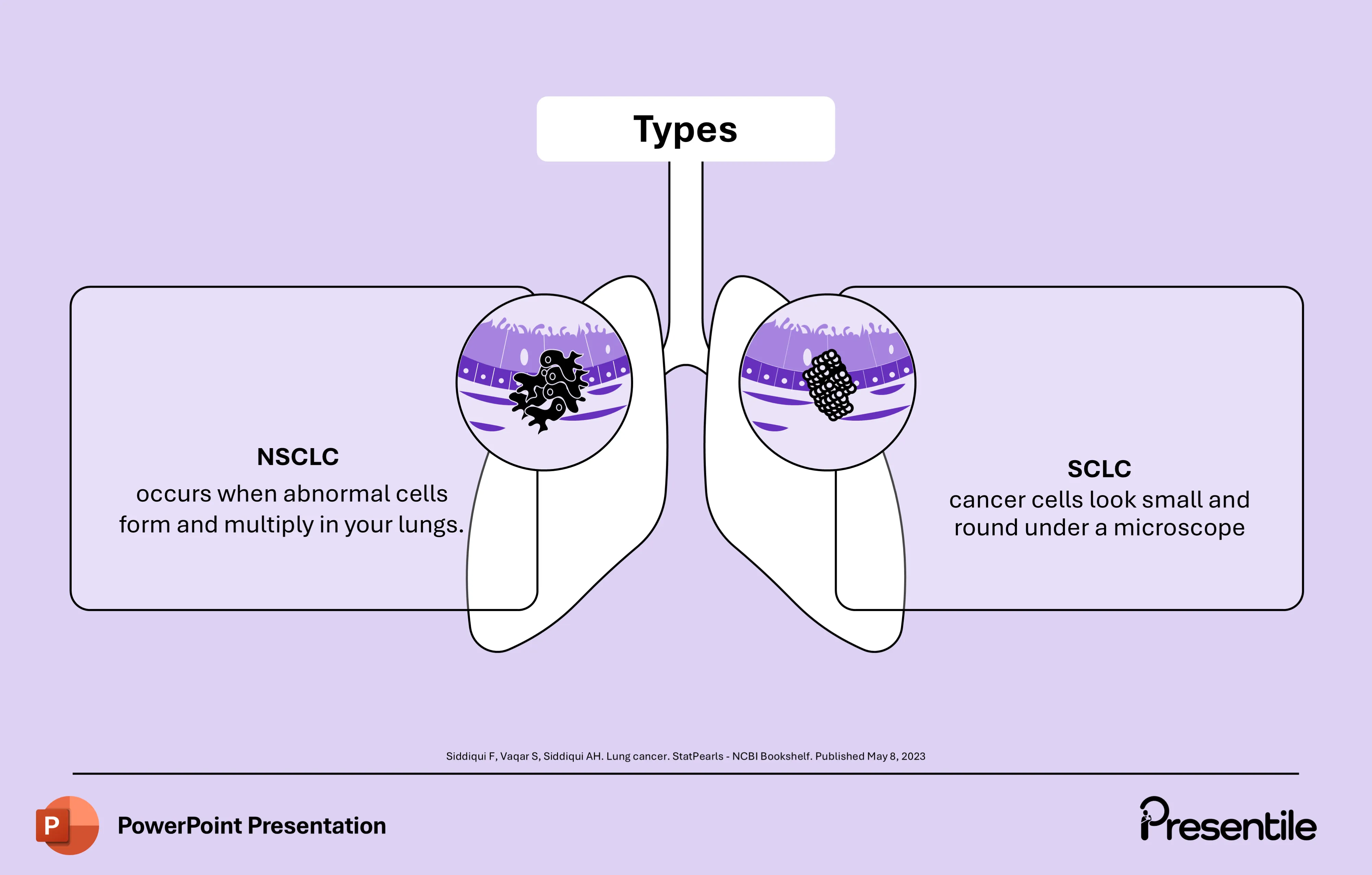
- This slide provides a clear visual and textual distinction between the two main types of lung cancer: Non-Small Cell Lung Cancer (NSCLC) and Small Cell Lung Cancer (SCLC).
- The design uses a pair of lungs with magnified sections to illustrate the differences in cell appearance.
- It explains that NSCLC occurs when abnormal cells form and multiply, while SCLC is characterized by cancer cells that appear small and round under a microscope. This side-by-side comparison effectively breaks down the fundamental pathological differences between these two major classifications of the disease.
Slide 12: Types of Lung Cancer (Comparison)
.webp)
- This slide compares the two main types of lung cancer: Non-Small Cell Lung Cancer (NSCLC) and Small Cell Lung Cancer (SCLC).
- The design uses a pair of lungs with magnified illustrations of the distinct cellular structures for each type. The key difference is highlighted by the text: the rate of spreading is slower for NSCLC and faster for SCLC.
- This slide provides a clear visual and textual distinction between the two types, emphasizing their different growth characteristics.
Slide 13: Lung Cancer: Screening
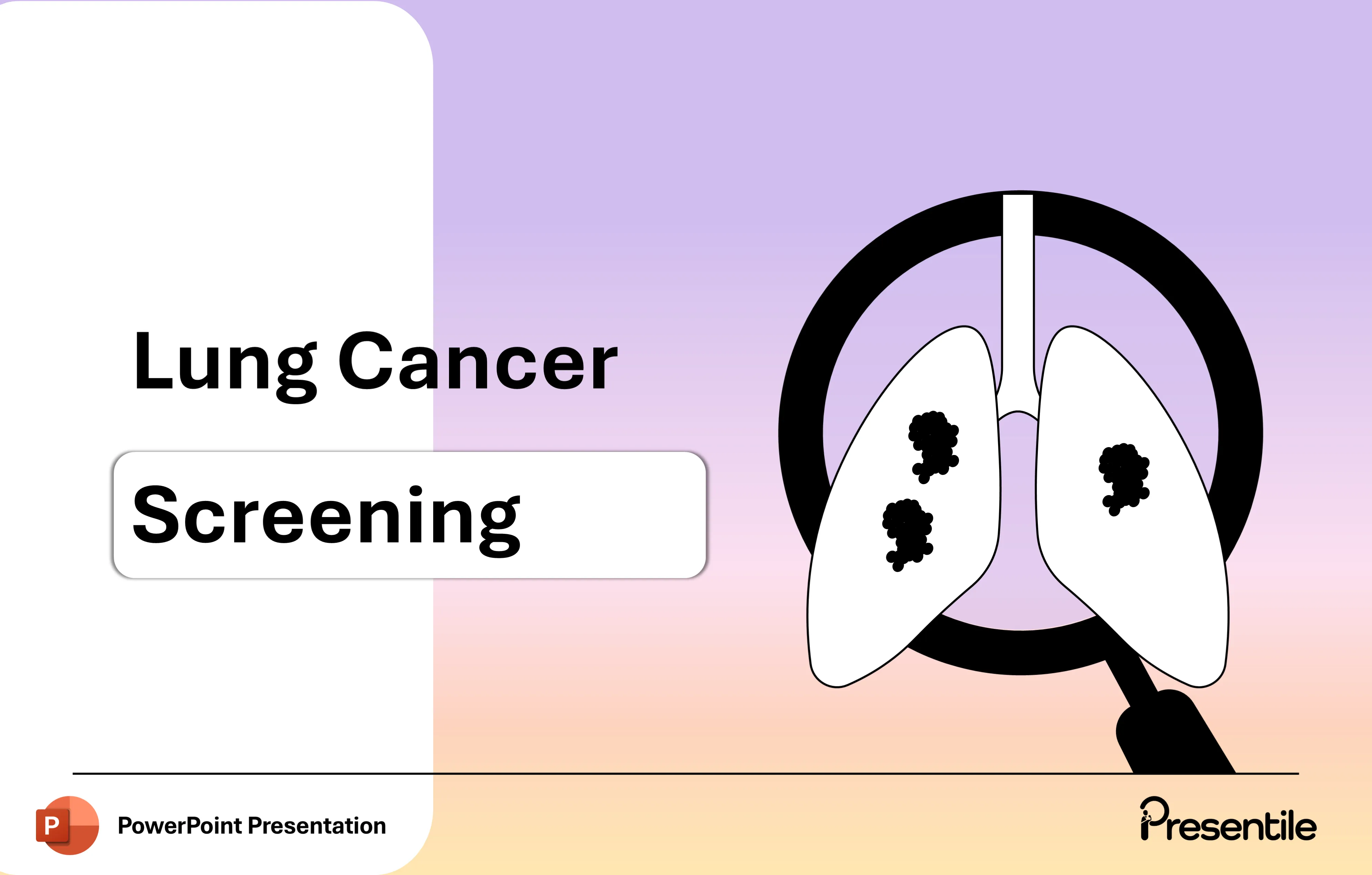
- This slide acts as a section break, introducing the topic of Lung Cancer Screening.
- The visual features a magnifying glass hovering over a pair of lungs with cancerous masses, symbolizing the diagnostic and screening process.
- The prominent text "Lung Cancer Screening" clearly signals a shift in the presentation's focus.
- This design effectively prepares your audience for a detailed discussion on the different methods used to detect lung cancer early.
Slide 14: Low-Dose CT Screening: The Advantages

- This slide highlights the advantages of low-dose CT screening for lung cancer.
- It presents four key benefits in a clean, circular format, each with a corresponding icon.
- The advantages are: it's safe, with 90% less radiation than regular CT scans; it's fast, taking less than 10 minutes; it's accurate, detecting both cancerous and non-cancerous lung nodules; and it's effective for diagnosis, even detecting the smallest nodules.
- This slide effectively communicates the efficiency and safety of this modern screening method.
Slide 15: Risks of Lung Cancer Screening
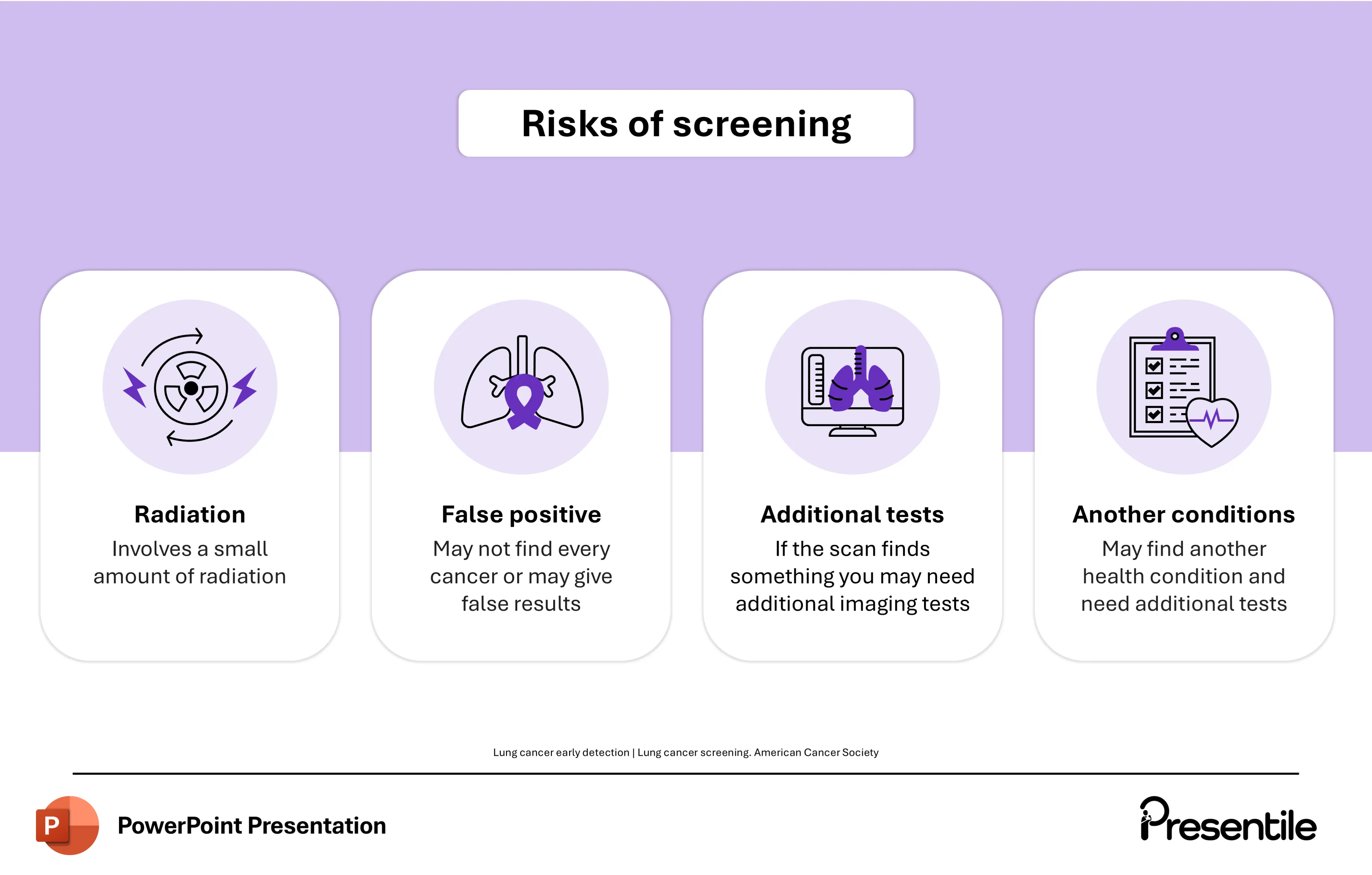
- This slide provides an overview of the potential risks associated with lung cancer screening.
- It uses four distinct icons to represent these risks. The first risk is radiation exposure, which, while small, is still a factor.
- The second is the possibility of a false positive, where the screening may not find every cancer or could give false results.
- The third risk is the need for additional tests, as any unusual findings often require further imaging. The final risk is the discovery of other conditions during the scan that may require follow-up and additional testing. This slide effectively communicates the potential drawbacks and complexities of the screening process.
Slide 16: Lung Cancer Screening Recommendations
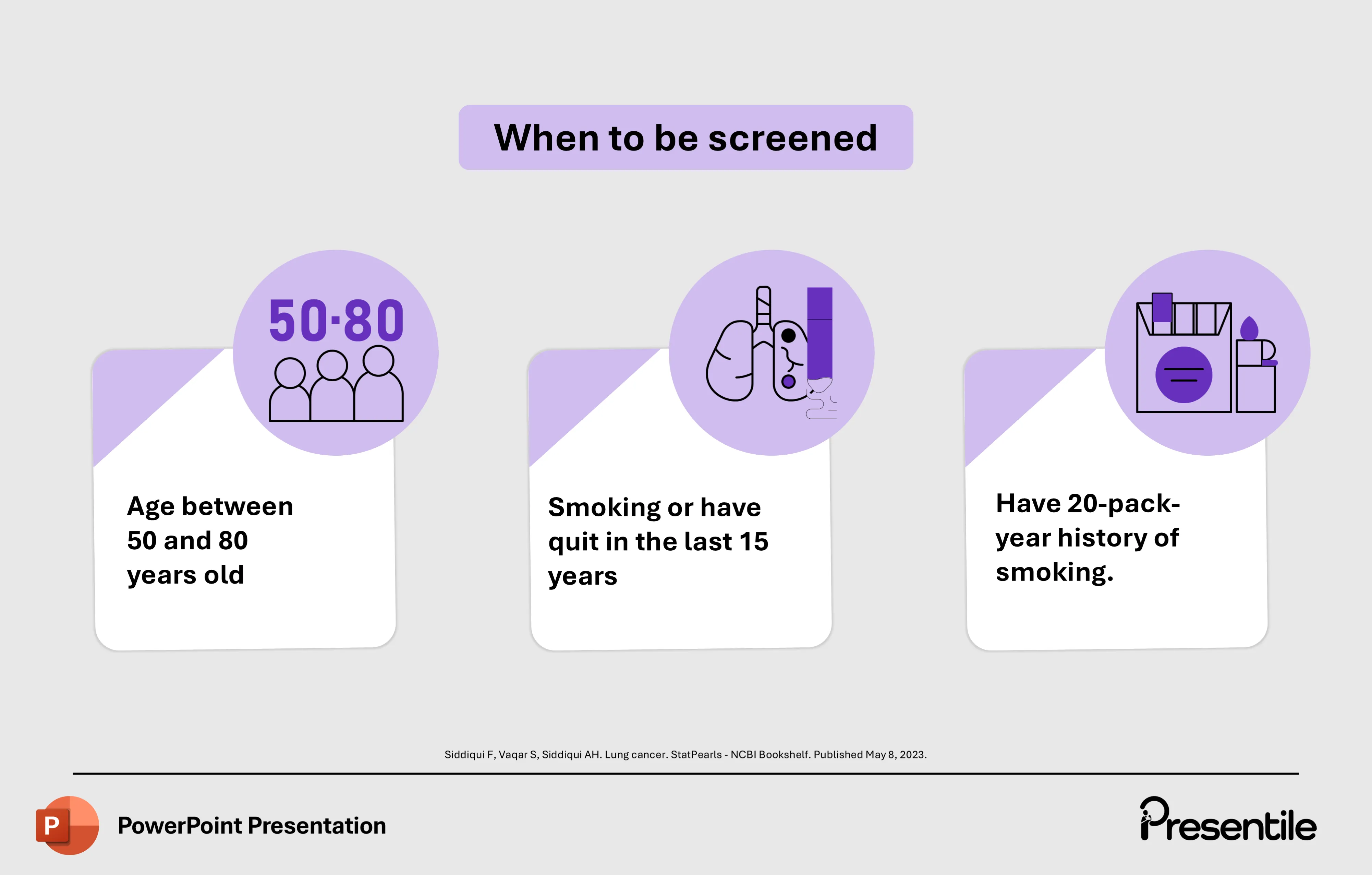
- This slide outlines the key criteria for when an individual should be screened for lung cancer.
- The slide identifies three primary factors in a clear, organized format.
- The first factor is age, specifying that individuals between 50 and 80 years old should be screened.
- The second factor is smoking history, recommending screening for those who smoke or have quit in the last 15 years.
- The third and final factor is a 20-pack-year history of smoking, a key measure of cumulative tobacco exposure.
- This slide effectively summarizes the crucial eligibility requirements for lung cancer screening.
Slide 17: Staging Lung Cancer
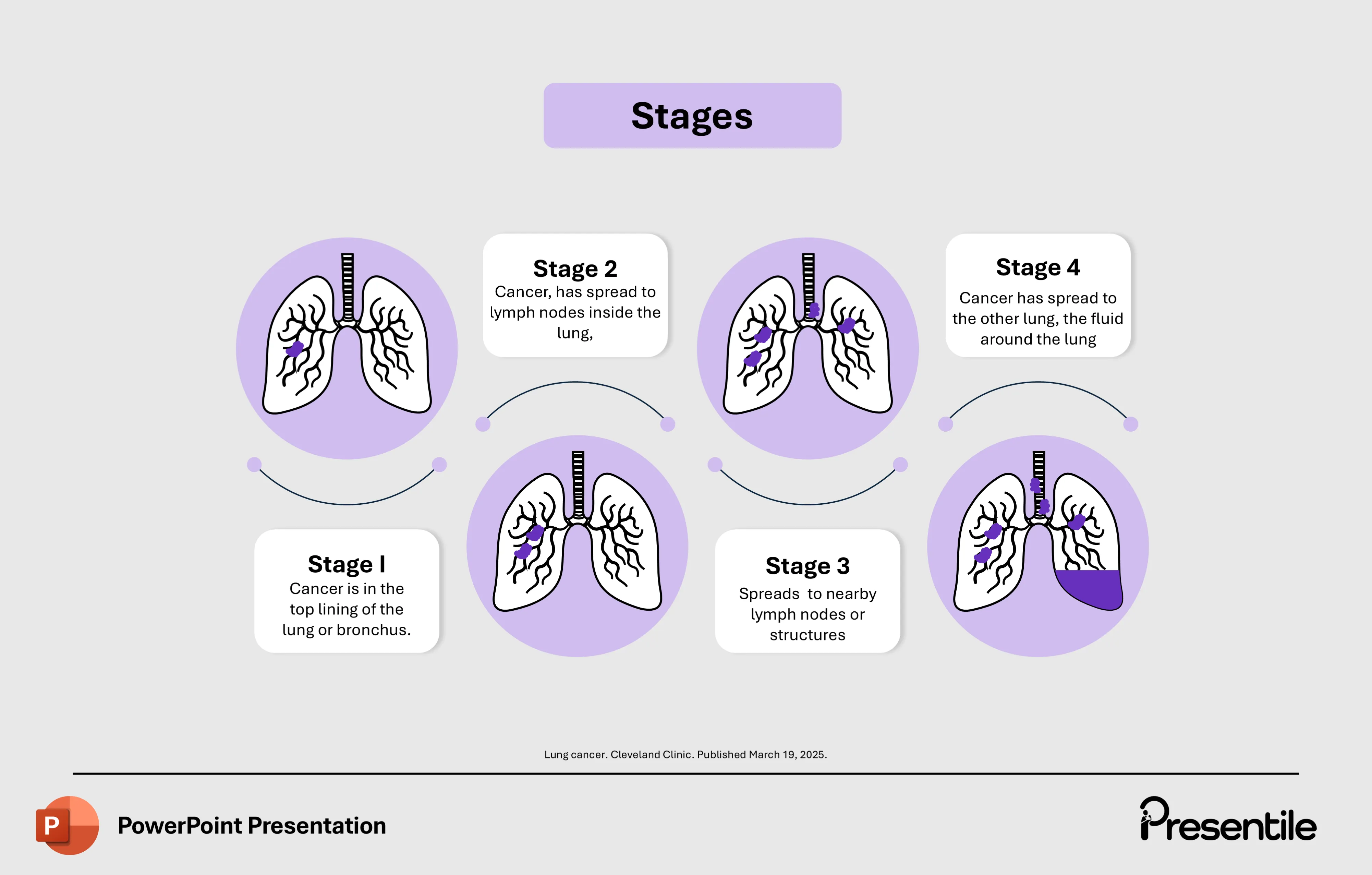
- This slide visually outlines the four stages of lung cancer. It uses a circular, sequential flow to explain how the disease progresses.
- Stage 1: The cancer is localized, found only in the top lining of the lung or bronchus.
- Stage 2: The cancer has spread to lymph nodes inside the lung.
- Stage 3: The cancer spreads to nearby lymph nodes or structures, indicating a more widespread regional involvement.
- Stage 4: The cancer has spread to the other lung, or the fluid around the lung, signifying that the disease has metastasized.
- This clear progression makes the staging of lung cancer easy to understand.
Slide 18: Lung Cancer: Treatment
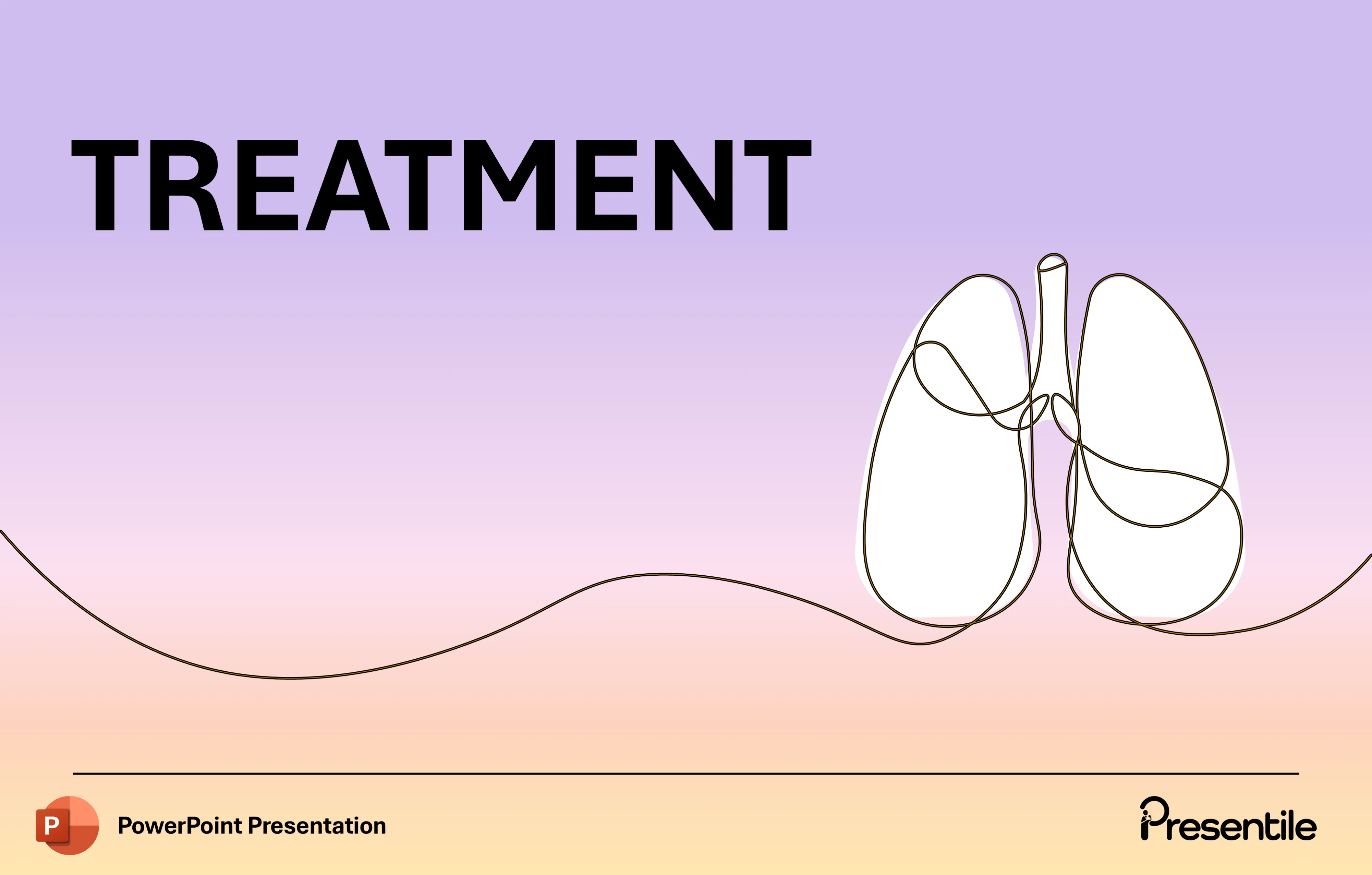
- This slide acts as a section break, introducing the topic of lung cancer treatment.
- The visual features a pair of lungs in a simple, continuous-line drawing, symbolizing the patient journey and the hope for a positive outcome.
- The bold, large text "TREATMENT" immediately draws attention and signals a new section in the presentation.
- This clean and impactful design is perfect for transitioning into a discussion on therapeutic interventions and management strategies.
Slide 19: Types of Lung Cancer Treatment
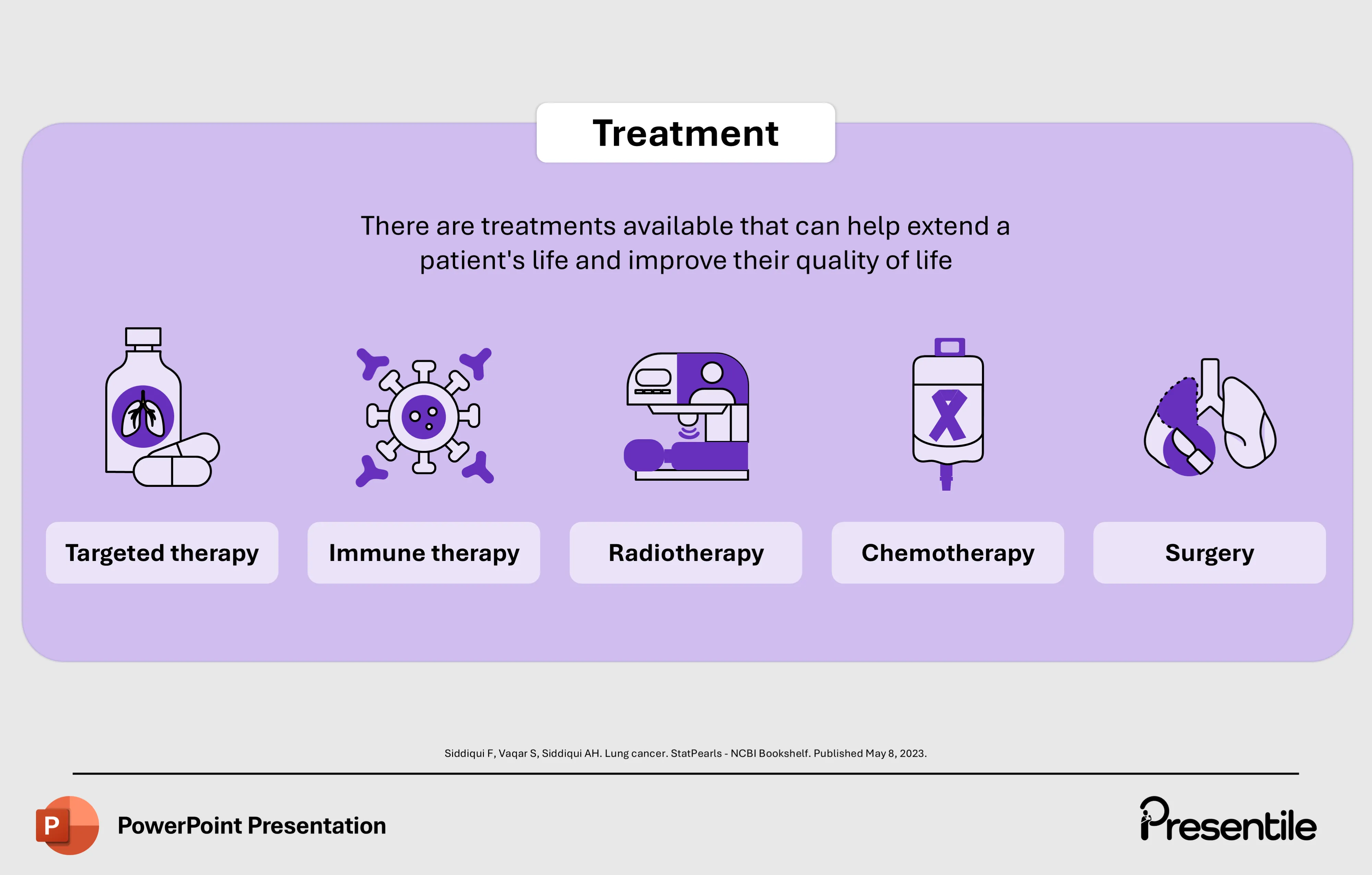
- This slide provides a comprehensive overview of the various treatment options available for lung cancer.
- The design uses five distinct icons, each representing a different type of therapy.
- These include Targeted therapy (represented by a pill bottle), Immune therapy (symbolized by a virus icon), Radiotherapy (a radiation machine), Chemotherapy (an IV bag with a ribbon), and Surgery (a pair of lungs).
- This layout effectively and clearly presents the range of medical interventions that can help extend a patient's life and improve their quality of life.
Slide 20: Types of Lung Cancer Surgery

- This slide details four different types of lung cancer surgery, visually illustrating the specific portion of the lung removed in each procedure.
- Wedge resection: This surgery is the least invasive, removing the smallest possible part of the lobe.
- Segmentectomy: This takes out one or more segments of a lobe while preserving half or more of it.
- Lobectomy: In this procedure, an entire lobe is removed to eliminate the cancer.
- Pneumonectomy: This is the most extensive surgery, removing the entire lung on the side of the tumor.
- The visual representations of the lungs with highlighted sections make it easy to understand the extent of each surgical procedure.
Slide 21: Lung Cancer: Prevention
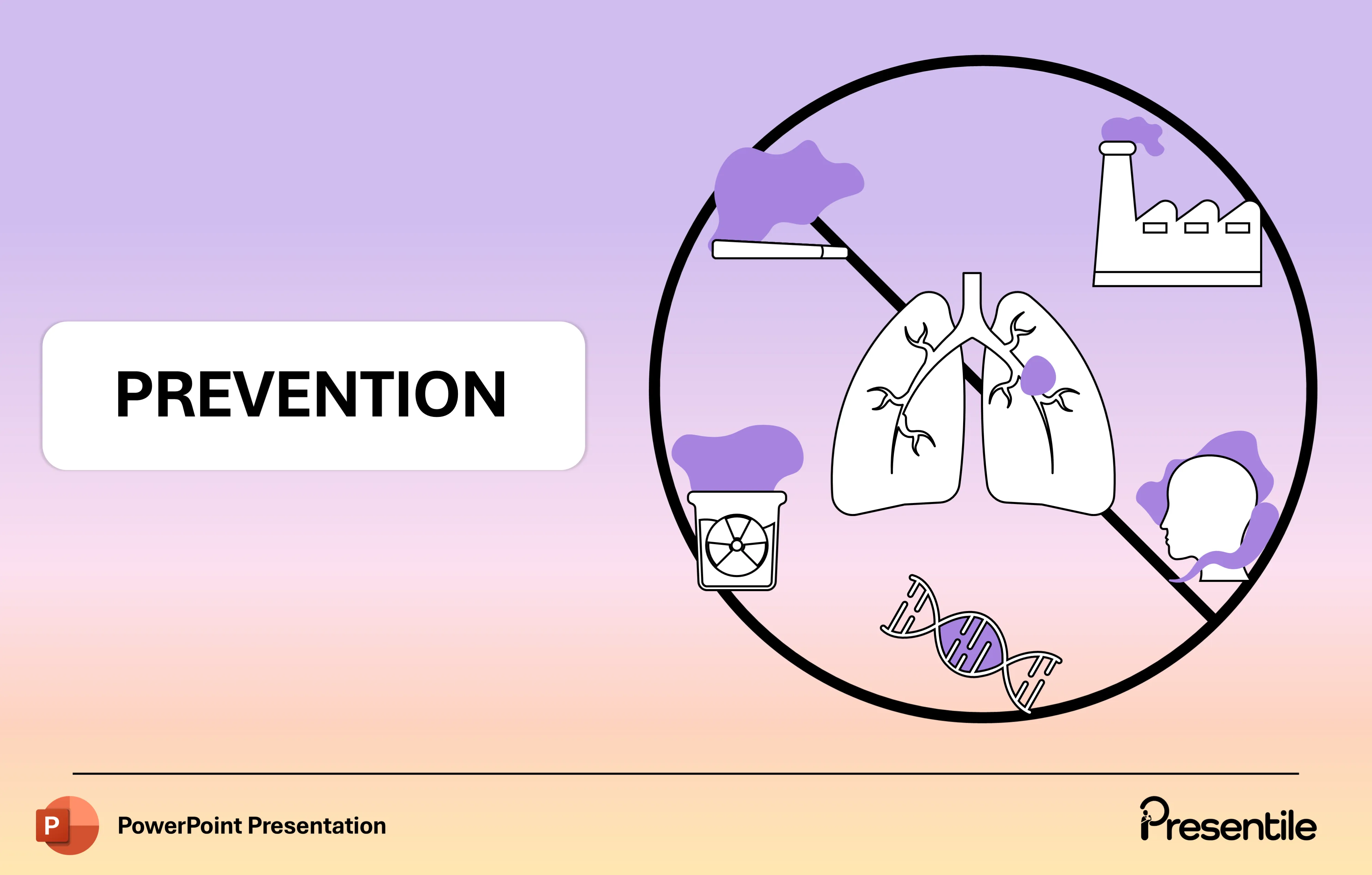
- This slide acts as a section break, introducing the topic of lung cancer prevention.
- The visual features a large circle divided into four segments, each with a different icon representing a risk factor (smoking, radiation, genetics, and pollution).
- The title "PREVENTION" is prominently displayed, signaling a focus on how to reduce the risk of developing the disease.
- This design effectively transitions the presentation toward actionable advice for a healthier life, empowering your audience with crucial information.
Slide 22: Prevention of Lung Cancer
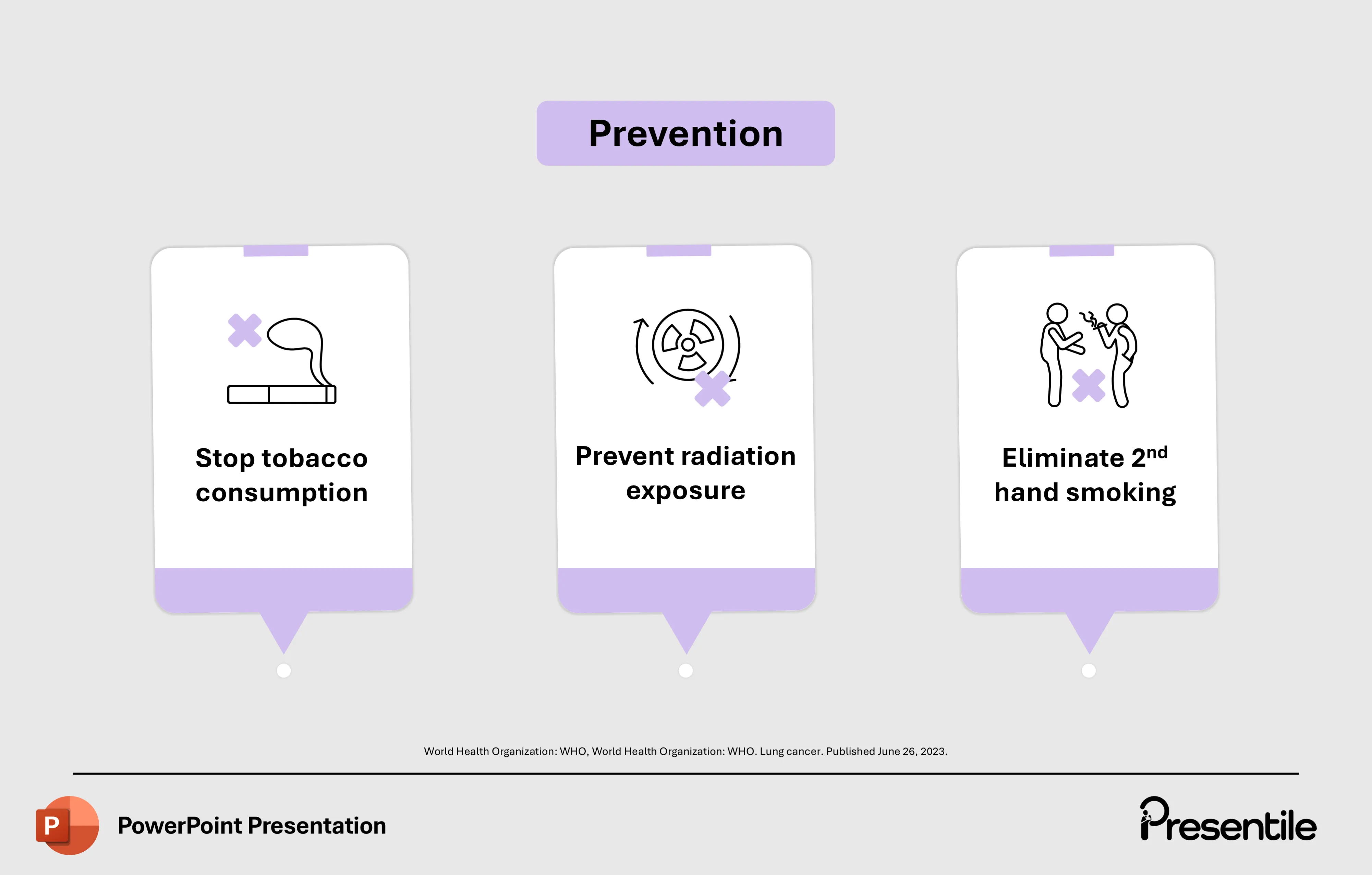
- This slide outlines three key strategies for the prevention of lung cancer.
- The design uses a simple, three-panel layout to clearly present each preventive measure.
- The first point is to stop tobacco consumption, symbolized by a cigarette with a red 'X'.
- The second is to prevent radiation exposure, represented by a radiation icon.
- The third is to eliminate secondhand smoke, depicted by two figures with a red 'X' over the smoker.
- This slide offers clear and actionable advice for reducing the risk of developing lung cancer.
Slide 23: Thank You

- This slide serves as a simple and effective closing statement for the presentation.
- The large, bold text "THANK YOU" is prominently displayed in the center, expressing gratitude to the audience.
- A white ribbon, symbolizing support and awareness, gracefully curves across the slide, subtly tying back to the presentation's themes of health and disease.
- The overall design is clean and professional, leaving a positive final impression.
Features of
Lung Cancer Presentation
- Fully editable in PowerPoint
- All graphics are in vector format
- Medically Referenced information and data
Specifications
 Slides count:
Slides count: Compatible with:Microsoft PowerPoint
Compatible with:Microsoft PowerPoint File type:PPTX
File type:PPTX Dimensions:16:9
Dimensions:16:9
Elevate Your Work with Our Innovative Slides
Thank you! Your submission has been received!
Oops! Something went wrong while submitting the form.
No items found.



